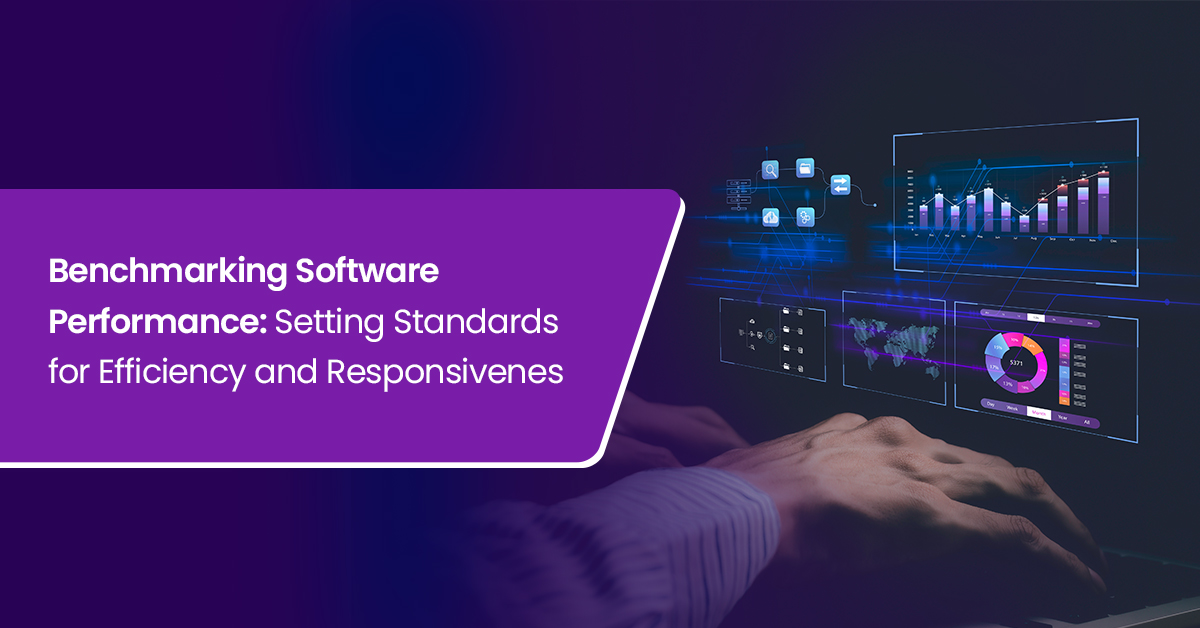In the modern digital age, users anticipate applications to be quick and smooth. A lagging or clumsy software encounter can quickly cause annoyance and abandonment. This is why we need software performance testing. For developers and testers, having set standards (benchmarking) helps them ensure that the applications they build, or test meet user requirements and provide a smooth experience.

Why Benchmark Software Performance?
Benchmarking software performance is more than just detecting bugs; it also includes setting clearly defined performance objectives and tracking the progress toward those objectives. This performance testing approach aims to compare all the past, present, and future updates of the software application against a set reference. Some of the benchmarking performance testing services' benefits include:
Improve User Experience: You can ensure your users have a smooth and fast experience by finding performance problems at the beginning of the development process. Thus, the application can keep them happy and interested in what you offer, leading to more use of your product or service.
Reduced Development Costs: Solving performance problems in the early stages is much cheaper than fixing them later, either during development or after the product has been released.
Enhanced Scalability: Benchmarks assist you in comprehending how your application functions under different loads. This is essential to ensure your application can scale up and satisfy future requirements.
Data-Driven Decision Making: Benchmarks provide solid data that can guide development choices. The information can be utilized to establish the importance of different characteristics, properly use resources, and monitor progress over time.
Setting Effective Benchmarks
The main point is to establish appropriate and quantifiable standards to achieve successful benchmarking. The method to follow is:
Define Your Users and Usage Patterns
Understanding your target users and how they interact with the application helps you decide what benchmarks to set. For example, if you have a mobile game, it would be crucial to establish standards for loading times and frame rates.
Identify Key Performance Indicators (KPIs)
Key Performance Indicators (KPIs) are measurable statistics that assess a certain part of your application's effectiveness. Examples of KPIs include:
■ The time between when a user initiates an action and when the application reacts to it.
■ The number of requests the application can handle per unit of time.
■ The amount of CPU, memory, and network bandwidth consumed by the application.
Set Realistic Goals
Benchmarks must be difficult yet reachable. When setting objectives, look at what the industry usually achieves and how your competitors are performing.
Document Your Benchmarks
Keep track of your benchmarks, ensuring that all people participating in the development procedure know about anticipated performance levels.
Benchmarking Different Application Types
The specific benchmarks you set will vary depending on the type of application you're developing. Here are some considerations for different application types:
Web Applications
Responsive times for common user actions (e.g., login, search, adding items to a cart) are critical for web applications. Additionally, you might want to benchmark page load times and overall application responsiveness under varying user loads (simulated by load testing services).
Mobile Applications
Mobile app performance benchmarks should focus on app startup time, screen rendering speed, and battery consumption. Benchmarks should also consider the performance of different device types and network conditions.
Web Services
Web services performance testing measuring factors like throughput, latency (response time), and error rates. Load testing services are valuable for simulating real-world usage patterns and identifying potential bottlenecks.
Best Practices for Benchmarking
Here are some additional tips for effective benchmarking:
Use Consistent Methodology
Maintain consistency in your benchmarking process for each iteration of your application. A consistent performance testing methodology enables precise comparisons and facilitates comprehensive progress tracking over time.
Leverage Performance Testing Tools
Use an effective performance testing strategy and tools to automate benchmarking and gather detailed performance information. These tools simplify benchmarking endeavors.
Establish a Performance Centre of Excellence (PCoE)
Implement a Performance Centre of Excellence (PCoE) for organizations with multiple applications. A PCoE provides centralized expertise and resources for benchmarking and performance evaluation. It also ensures a uniform approach to performance testing throughout the organization.
Continuously Monitor and Update Benchmarks
Regularly monitor the performance of your application and update benchmarks as needed. This ensures that benchmarks remain relevant and aligned with user demands.
Conclusion
Every organization seeking to provide a top-notch user experience must engage in the critical procedure of benchmarking software performance. By establishing explicit and quantifiable benchmarks, organizations can ensure that their applications will meet user demands and maintain competitiveness in the industry.
An intricately outlined software performance testing strategy, including benchmarking, is vital throughout the development cycle. This includes not only initial development but also continuous maintenance and updates.
By utilizing performance testing services for application performance testing or load testing services, you can discern and rectify any performance obstacles before they detrimentally affect your users. The success of software performance testing requires an iterative approach. Continuously benchmarking, monitoring, and refining your approach ensures that your applications provide a seamless, prompt, and delightful user experience.






